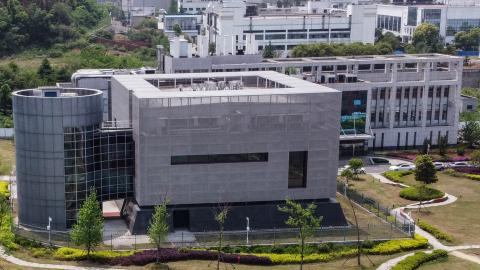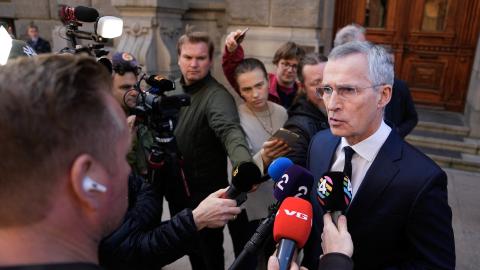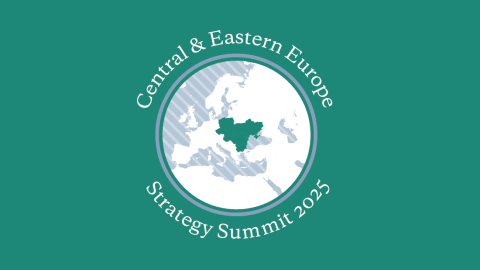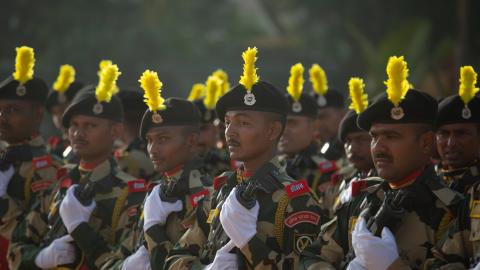Signaling the importance of diplomatic engagement to counter China, Secretary of State Marco Rubio met with his counterparts in the Quad on his first day in office. This security initiative between the United States, India, Japan, and Australia was started by the first Trump administration. However, stumbles by the Biden administration caused unnecessarily bumpy U.S.-India relations, which stunted the progress of the Quad security collaboration.
Some Indian leaders are optimistic and even confident that President Donald Trump will help smooth things out and elevate India’s role in its global ambitions, including in the Quad context.
During a recent trip to India hosted by the India Foundation and my employer, the Hudson Institute, I was struck by how unworried and even gleeful some senior Indian officials of the ruling Bharatiya Janata Party, or BJP, were about Trump’s return to power. The reasons were simple: To these Indian officials, the election results showed the Americans’ defeat of “wokeism” and progressive cultural ideology, or at least a significant rejection of it. And that rejection portends relief from the Democratic administration’s haranguing of conservative allies and partners, from India to Poland and Japan. Former President Joe Biden accused Japan and India of being “xenophobic” at a campaign event last May.
Plus, Trump asserted a kind of renewed permission for each country’s leaders to defend their national borders and embrace the cultures and traditions that inform the interests of their people. Indian intellectuals presented at the latest National Conservatism Conference, a gathering of the “New Right” led by the conservative Israeli scholar Yoram Hazony. Prime Minister Narendra Modi’s successful efforts to unite the diverse nation he leads under the banner of Hindu “culture” — not religion, as BJP officials are quick to discern — are crucial for India’s continued economic rise, its evening of economic mobility within a complex, persistent caste system, and lifting more Indian families out of abject poverty.
But the uptick in collaboration between the BJP and American conservatives should not be understood as confidence in a budding U.S.-India alliance. Modi has made clear that India will remain nonaligned and avoid any formal alliance arrangement with the U.S. It is a member of BRICS, after all — although one Indian was quick to remind me that India is the only BRICS nation that supports the dollar and acts as a foil to any notion of a BRICS currency. It’s a point Trump would certainly appreciate, considering his recent denunciation of the BRICS effort to undermine the might of the U.S. dollar.
But the U.S. does not need India to be a formal ally for it to be a productive and even vital partner as Washington grapples with the rise of China and the budding axis of revisionist authoritarian powers in China, Russia, North Korea, and Iran.
India is the world’s most populous democracy with great economic growth potential, and while New Delhi seeks to play a larger role in shaping the current world order, it shares America’s interest in preventing the wholesale destruction of that world order and in stopping the Chinese Communist Party’s revanchism. The disagreements between the two countries are not immaterial, but the opportunity and shared interests are so great that the U.S. should bolster investment in its diplomatic outreach to India.
Our Indian hosts took our group of American researchers all the way up into the Himalayas in Tawang. There, the Chinese have threatened to take territory in the Indian state of Arunachal Pradesh, a region that India has administered for decades but that China has erroneously claimed is rightfully its own. The list of what the CCP considers China’s “core interests” is growing, and it includes Arunachal Pradesh. In late 2022, Chinese and Indian forces had an unarmed clash along the Line of Actual Control separating Tibet and India’s Arunachal Pradesh. While there, in this breathtakingly scenic land, more than 15,000 feet above sea level, our American delegation observed the People’s Liberation Army officers on their side of the line.
The Buddhist occupants of the monasteries on the Indian side of the border and their surrounding supportive communities are peaceful, quiet, and proud Indians. They reject the Chinese claim to their lands and wish for their fellow Buddhists in Chinese-controlled Tibet to enjoy the same peace and liberty as themselves.
China’s erroneous claims to Indian territory were a theme of the trip. At one point, one of the Americans asked an Indian official why India had not sided with the democratic coalition of countries supporting Ukraine’s fight against Russia — a close partner to India and the main provider of arms to the Indian military. The Indian official answered with a question: “Where were the world’s democracies when China was threatening the world’s largest democracy?” It doesn’t answer why India continues to cooperate with Russia, but the official’s response is instructive, and it serves as further evidence of how the Biden administration’s “democracy vs. autocracy” framework oversimplified world affairs.
This false dichotomy is also related to India’s concern about neighboring Bangladesh. Prior to the overthrow of former Bangladeshi Prime Minister Sheikh Hasina, the U.S. publicly criticized the Hasina government and sanctioned many pro-Hasina people and groups in the country due to perceived democratic backsliding. The Biden administration took these actions despite repeated protests from Indian officials, who view cooperation with Bangladesh as essential to defending India’s northeast from Chinese aggression, given only a narrow corridor to the north of Bangladesh connects the northeastern regions of India to the rest of the country. While the U.S. and other Western nations celebrated a victory for democracy after Hasina’s ouster, the world’s largest democracy faced a far more fraught environment from authoritarian aggression and the threat of Islamist extremism on its borders.
But what are we to make of India’s positive relationship with, and even reliance on, Russia? More than 60% of Indian military weapons are Russian, a major challenge to deeper military-technical collaboration with the U.S. Indian officials have been careful to avoid explicitly denouncing Russia’s decision to violate Ukrainian sovereignty and continue its bloody war. Still, Indian officials have conveyed unhappiness with Russia’s war and a desire to see it come to an end as soon as possible and have sought to decrease New Delhi’s reliance on Russian arms. Interestingly, part of its effort to diversify its arms imports has included importing more from Israel. And while India has a stable relationship with Iran, Indian officials, to varying degrees, made clear to our American delegation that they understood and supported Israel’s war against Iranian terrorist proxies. If anyone understands the threat posed by Islamist extremism, it is India.
The Biden administration chose not to implement sanctions against New Delhi for buying Russian oil during Russia’s war of aggression against Ukraine, revealing an appreciation for the value India provides in other areas. Still, Biden was not able to resist occasionally revealing a frustration with India over its unwillingness to join the coalition of supporters of Ukraine.
The first Trump administration, for its part, chose to err on the side of preserving positive gains with India rather than risk undermining them when it waived sanctions on India for acquiring Russian S-400 surface-to-air missile systems. India’s collaboration within the Quad framework to build up defenses with the U.S. and its close regional allies is a natural speed bump to Chinese military adventurism, posing increasing military challenges to Chinese President Xi Jinping as collaboration progresses. And while it would be simpler for the U.S. if India were to side with the U.S. and other democracies fully to support Ukraine against Russia’s aggressive and illegal invasion, it is not necessarily true that the U.S. needs Indian support to accomplish its strategic goals in Europe. If Europeans rebuild their respective defense industrial bases, support Ukraine in significant and meaningful ways, and invest in energy alternatives that do not rely on Russian gas, NATO can manage more than adequately to deal with the Russian threat.
Indeed, India’s positive relationship with Russia is a bit of a foil for Russia’s growing partnership with China, which could be a useful wedge. The partnership between Moscow and New Delhi is rooted in the days following India’s independence from the United Kingdom and the 1947 partition of British India. It is too much to expect India to spoil its relationship with Moscow, especially considering the Americans’ bipolar policy toward Pakistan. The first Trump administration rightly stopped arms sales to Pakistan in 2018 over the country’s provision of a haven to terrorist groups. The Biden administration reversed course and approved a $450 million arms deal with Pakistan, including the upkeep of F-16 fighter jets, which India was adamantly opposed to. A return by the second Trump administration to the first’s skepticism of Pakistan would certainly improve U.S.-India relations.
There are two last issues that will now be sticking points in the U.S.-India relationship for the new Trump administration to contend with. First, Modi’s effort to reinvigorate India’s sense of national pride and purpose has significantly harmed India’s minority Christian community. The Indian government’s policy is that it remains tolerant of India’s diverse religious population and that all people can worship as they see fit if they remain in accordance with Hindu culture. The application of this policy is, in fact, resulting in the persecution of Christians who are following Indian law and practicing their faith. Modi’s government would be wise to come to a better understanding with these Christian communities and permit them to live peaceful lives according to the teachings of their faith.
Second, Canada has accused the Indian government of being behind the assassination of Hardeep Singh Nijjar, an Indian-born Canadian national and Sikh separatist. Nijjar was an outspoken supporter of the idea of an autonomous homeland for Sikhs in India. Extrajudicial killings at all, let alone on the soil of one of America’s closest security allies, are, of course, outrageous. And if true, the U.S. should, privately, express the intolerability of that practice to New Delhi. U.S. officials should encourage our Canadian allies to take a similarly private approach in their dealings with the Indian government.
Despite these matters, the Trump administration has an enormous opportunity to build on the success of the U.S.-India partnership.
First, the Trump administration should ensure U.S.-India relations are prized and that diplomatic progress continues. The president and first lady Melania Trump may want to ensure hosting Modi is a priority and express optimism about their cooperation.
Second, there should be efforts to understand better the BJP’s efforts toward unity inside India and allay concerns that the U.S. is threatening Indian unity. At the same time, American diplomats should engage the BJP-aligned Hindu nationalist organization Rashtriya Swayamsevak Sangh to express the American view that peaceful coexistence and Indian nationalism are not incompatible with respecting the religious expression of Christian communities. Ending American haranguing of conservative countries over their failure to be “progressive enough” does not mean that America is abandoning its commitment to natural rights. Modi should ensure the most fundamental right of the Indian people to practice their religion freely and peacefully according to the dictates of their consciences.
And third, the Trump administration can better appreciate the foil India can pose to the China-Russia partnership. To exploit this possible wedge, the U.S. should increase its efforts to cooperate militarily with India in the forward deployment of key U.S. weapon systems to deter Chinese aggression, and the Trump administration should continue to support collaboration within the Quad framework as it did during Trump’s first term.
China’s military is growing at a pace that makes it exceedingly hard for the U.S. to make the necessary changes to its defense industrial base and deploy military capabilities in time to thwart Chinese aggression. But U.S.-India military cooperation and greater understanding and trust between the world’s two largest and most powerful democracies can buy the U.S. and its allies and partners time, further complicate Chinese calculations, and bolster the U.S.-led alliance and partner structures that maintain and protect peace.



















